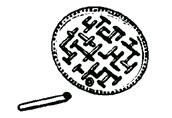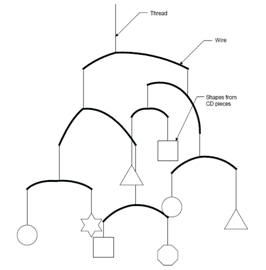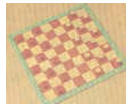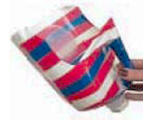December 2008 Cub Scout Roundtable Issue |
Volume
15, Issue
5
January 2008 Theme |
Theme:
A-MAZE-ing GAMES
Webelos:
Fitness and Scientist
Tiger Cub
Achievement 3 |
PACK AND DEN
PROJECTS & ACTIVITIES
DEN AND PACK ACTIVITIES
Catalina
Council
Have a pack family game night.
Build homemade board games.
Have a pack carnival and have each den build carnival games
for the event.
make picture puzzles.
Tour a facility that makes games.
Create a Scouting game midway.
Learn about the history of games. Invite a parent or
grandparent to share about the kids of games they used to play. Have them teach
one of the games they talk about.
Alice, Golden
Empire Council
«
Make a life size maze or labyrinth – see Theme Related for ideas
and instructions- it could be as simple as marking out one in the sand or using
chalk on concrete; invite everyone to participate and take lots of pictures.
You could even lay out one for the pack meeting.
«
Have each family bring a maze to the pack meeting – then let
everyone go around and try to “finger walk” the solution to all the mazes- ask
families to list web sites if they use them
«
Talk about Internet safety with the boys and parents – since they
probably love to play games and online mazes, it would be good to reinforce how
to stay safe
«
Try lots of paper & pencil mazes – many resources available
online; check Web Sites Section. Challenge each family or boy to bring at least
one idea to the pack meeting, then provide copies for everyone in an A-Maze-ing
Cubs booklet for your pack.
«
Ask a grandparent or older leader to come and share the favorite
games and puzzles they enjoyed as children – try some of them as a den
«
Laminate a map of your community and use it like a paper maze –
locate two places on the map, then have boys take turns drawing different ways
to get from the beginning to the ending point; use a marker, then wipe the map
clean and choose another two places on the map
«
Visit a maze or labyrinth in your area. Check the Maze World and
other sites in the Web Site section to find various mazes or labyrinths just
about anywhere!
«
If you are going to visit a nearby maze or labyrinth, let the boys
find the way on a map – see how many different ways they can find, then discuss
which way would be best, and why
«
Have each boy make his own album of different mazes, or a poster
to explain mazes and/or labyrinths – Display at the Pack Meeting
«
Check for some great books about mazes at your local library –
they may even have a video or CD of a program about mazes and labyrinths.
(There have been some on PBS) Check with the Reference Librarian for help.
«
Have a “Scavenger Hunt” for puzzles, riddles and mazes in old
copies of Boy’s Life – make copies of the boy’s Top Ten choices and give each
family a copy – a good way to convince them how valuable Boy’ Life really is!
«
Encourage each family to try a Family Fire Drill Maze – after
discussing how to get out of each room, and why you need to crawl and check
doors for heat, do a nighttime drill with all the lights turned off; remind
them that even without smoke, it can seem almost like a maze; let everyone try
it from different locations so they know the routes to take. When everyone
knows how to do it, you could make it more challenging for older kids by adding
obstacles and forcing alternate routes.
«
If you are doing the Honesty Character Connection this month, take
the phrase “Honesty is the Best Policy” and let the boys come up with ideas that
prove it; discuss real-life situations like playing games and how dishonesty
hurts everyone; make the connection between good sportsmanship and honesty
«
Use the streets around your den meeting place as a “real-life”
maze – as you walk, have the boys point out where the route could change, and
give points for each time they point out rules of good or bad street safety
Pinewood Derby Ideas:
Alice, Golden Empire Council
«
Give a “Sweet” Participation Award for all Pinewood Derby
participants. Create a candy bar wrapper with a Pinewood Derby theme and wrap
it around a real candy bar.
«
Be sure every boy and car get recognition – many packs have a
guest committee to judge the cars on “originality, best paint job, most creative
design, best use of decals” – the point is to award each car some award!
«
Talk about Good Sportsmanship in your den and before the races
begin – You could even give a “Good Sport” award at the pack meeting!
«
Make a Stand for a Pinewood Derby car – Get advancement or
elective points while using tool or Craftsman skills to make a stand for each
boy’s car at a den meeting. (There are several simple plans available online –
just google pinewood derby car stands and choose one)
«
Have a special Pinewood Derby Workshop – experienced derby
builders and those with tools and equipment could share their expertise with
boys and parents who need help.
«
Make sure every boy has a “mentor” if he needs help with his
Pinewood Derby Racer – single parent moms or dads may not be able to provide
needed help or may lack equipment or experience.
«
Every boy should get his kit in plenty of time to work on it –
and every family needs to be invited to come!
«
Decide on the rules for your Pinewood Derby and make sure everyone
gets a written copy – if you need ideas, check the usscouting website or just
google it to see what other units have done.
«
Have a special event for siblings or parents – some packs have a
special race where siblings and/or parents can race old cars or original ones
they have created.
«
Invite older members of the community to this special event – they
could even be “officials” and be given fancy name tags to wear while helping
judge the cars, or just be a cheering section.
«
Look for real racing supplies you can borrow check to see if pack
families know of a local race car driver, NASCAR fan, dealer or supply store
that could lend flags, posters, or even a real race car to be parked outside the
event!
Magnet Maze
Sam Houston
Area Council

Materials –
Large heavy-duty paper plates,
Paper drinking straws or thin
strips of cardboard,
Washers,
Craft sticks,
Small magnets,
Glue
Directions –
P
Glue straws or strips of cardboard in a maze pattern onto a paper
plate, being sure to leave enough room for the washer to travel through the
maze.
P
Place a washer on the plate in the maze.
P
Next, glue a small magnet onto one end of a craft stick and let
the glue dry.
P
Hold the “handle” end of the craft stick beneath the plate and
point the “magnet” end directly under the washer.
P
Guide the washer through the maze with the magnet.
Magnetic Maze II
Alice, Golden
Empire Council
Here's a fun way to create a maze and add the challenge of
having to move through the maze using a magnet.
Materials:
Large piece of paper or a maze you have printed out
A small magnet,
A large piece of paper
Either a paperclip or a metal washer, (or some other small
item that would be attracted to your magnet)
Directions:
First, be sure to test your magnet and playing pieces with
the magnet to make sure the magnet has the necessary power to go through your
paper.
Version #1:
ü
Ask the First person to draw a wiggly pencil line on a large piece
of paper - encourage them to make it almost cover the page, and to cross over
itself.
ü
Then ask the Second person to draw a second parallel line to make
a "roadway -
ü
Together, the first and second person decide where to make the
"dead-ends" by how they draw the second line - if the line goes over the first
line, the "roadway" continues; if the line goes "under the roadway," the line
ends at that point.
ü
If you are making a roadway for your "car" to ride along, you
could even add bent-paper tunnels, railroad crossings, and other details.
Version #2:
An existing maze can be used - it may need to be enlarged
so that the paperclip or other playing piece can stay within the "corridors."
To Play:
In order to complete the maze, the person must hold their
magnet under the piece of paper and move their paper clip or other
playing piece using only the magnet - it's harder than it sounds!
Additional Challenges:
Time each person and reward the one who takes the least
time to complete their maze.
Player starts with 10 points - each time he hits a "dead
end" he loses 2 points.
If a person "loses" their playing piece by having the
magnet move away from the playing piece, they lose 3 points.
Winner is the one with the most points left when he completes the maze.
Egg Carton Mancala
Wendy, Chief Seattle Council
Directions:
ü
Remove the top of the carton from the bottom by cutting along the
hinge.
ü
Recycle the extraneous portion used to keep the carton closed when
used to store eggs.
ü
Set the bottom aside for later.
ü
Cut the top of the carton in half, crosswise. (Cut across the
short axis.)
ü
These pieces will be used as the end cups of the Mancala board.
ü
Decorate egg carton as desired.
ü
Slide the two halves of the top underneath each end of the bottom,
extending beyond the bottom by a couple of inches.
ü
Fasten together using the tape or glue.
Rules:
Deposit three paper clips (or
the markers of your choice) in each of the twelve cups in the bottom of the
carton.
Leave the end cups (made from
the top of the carton) empty.
Place the game board between
the two players, with the larger cups on the right and left of the players.
The side of the board closest
to each player, as well as the end cup on each player's right belongs to that
player.
Players take turns picking up
all the paper clips from one of their cups, (except for the end cups,) and then
depositing one in each consecutive cup (including the end cups) in a clockwise
direction, beginning with the cup to the right of the one from which the player
took the paper clips.
For example, if, on the
first turn of the game, player 1 picks up the paper clips from the fourth cup
from the right, he would then deposit a paper clip in the third cup from the
right, the second cup from the right, and finally, the rightmost cup.
If the first player had
started with the rightmost cup, he would have deposited one paper clip in his
end cup, then continued around the board, depositing paper clips in his
opponents first two cups.
If, however, player 1 had
selected the paper clips in the third cup from the right, he would have ended by
placing his last paper clip in the end cup. When a player deposits the last
paper clip in the end cup, he gets another turn, and may select the paper clips
in another of his cups, continuing in the same manner.
The object of the game is to
end your turn with all of the cups on your side empty (excluding, of course, the
end cups.) Note that in this version, the number of paper clips, if any, in the
end cup has no bearing on the game play.
African symbols may be found
at these websites:
http://www.welltempered.net/adinkra/htmls/adinkra_index.htm
http://www.wisegorilla.com/images/african/african.html
If the boys draw the symbols
on stickers, or paper, and glue them to the bottom of the egg carton cups, it
will work better. The bottoms of the cups are bumpy, and hard to draw on.
Mirror Mobile
Catalina
Council
Materials:
·
Aluminum wire (use a length of main feed electrical House wire,
stripped and unbundled)
·
Junk CDs (e.g., AOL)
·
Thread
·
Hot glue
·
Utility knife

Directions:
ü
Ahead of time, cut the CDs into various shapes. You will need a
dozen or more for each mobile.
ü
Also, cut the aluminum wire into different lengths (3” to 6”). Put
a slight hook on each end of each length of wire to give a place to tie the
thread.
ü
Cut the thread into varying lengths (6” to 10”).
ü
Have the kids glue one end of each thread sandwiched between two
pieces of CD.
ü
Have them tie and glue the other ends to ends of the some of the
wire pieces.
ü
Tie and glue the centers of these pieces to ends of other wires
forming a mobile. (This is really hard to describe in words—how about looking at
a picture instead!?)
Checkerboard
Catalina
Council

Materials
ü
1 piece of plywood cut (square) to size you want
ü
Felt in two different colors
ü
Paint (enough to cover the top of the plywood)
ü
Paint: small amount, 2 colors (same colors as felt)
ü
Bag of round wood discs (available at craft stores)
What to do:
1.
Cover top of plywood with 1 or two coats of paint, (color of
choice).
2.
Allow each coat to dry completely.
3.
Cut 64 squares of felt, 32 of each color. Be sure they are all
the same size and will fit on the plywood size you have decided on.
4.
Use the two colors of paint that you have decided on to paint
24 wooden discs. 12 of each color.
5.
Allow to dry.
6.
Play Checkers
Ball Catchers
Catalina
Council

What you'll need:
2 plastic milk cartons or
laundry detergent bottles
Sharp scissors. Large
detergent bottles work well, too, and they are heavier plastic!! CD
Colored electrical tape or
"Painters" paint markers
Ball to play with (I use
socks rolled into a ball CD)
How to make it:
Wash and let dry the milk cartons well before starting.
Note:
It is easier to cut the bottom off of the containers first.
ü
Use the sharp scissors to cut the milk carton or detergent bottle.
ü
First cut off the bottom, then cut a U shape under the handle.
Make sure you don't cut into the handle so you can hold on the ball catch. (see
photo)
ü
Use the colored electrical tape or "Painters" paint markers to
decorate the milk cartons.
ü
Have fun playing catch and toss with these fun toys.
MORE GAMES AND ACTIVITIES
Wendy, Chief Seattle Council

From the Cub Scout Leader How-To Book –
ü
Puzzles, p. 5 – 25-26.
Materials found in Baloo's Bugle may be used by Scouters for Scouting activities provided that Baloo's Bugle and the original contributors are cited as the source of the material. |
|





